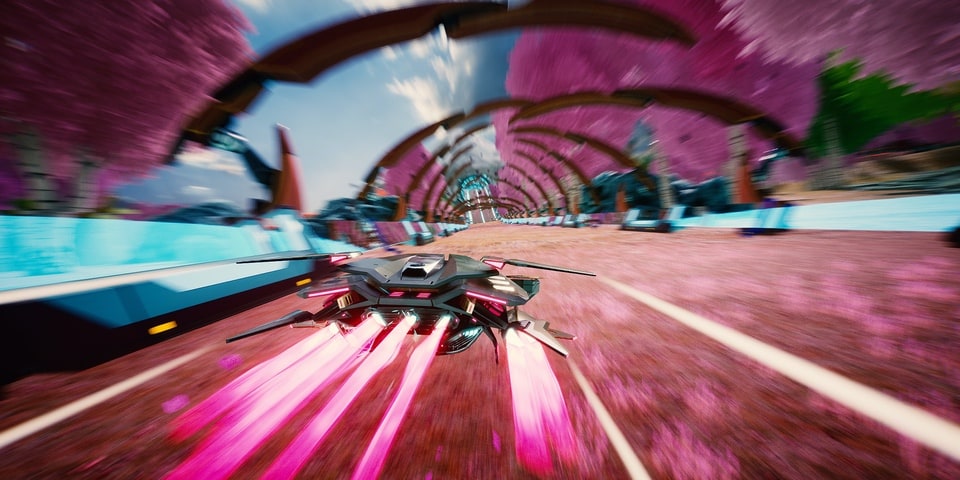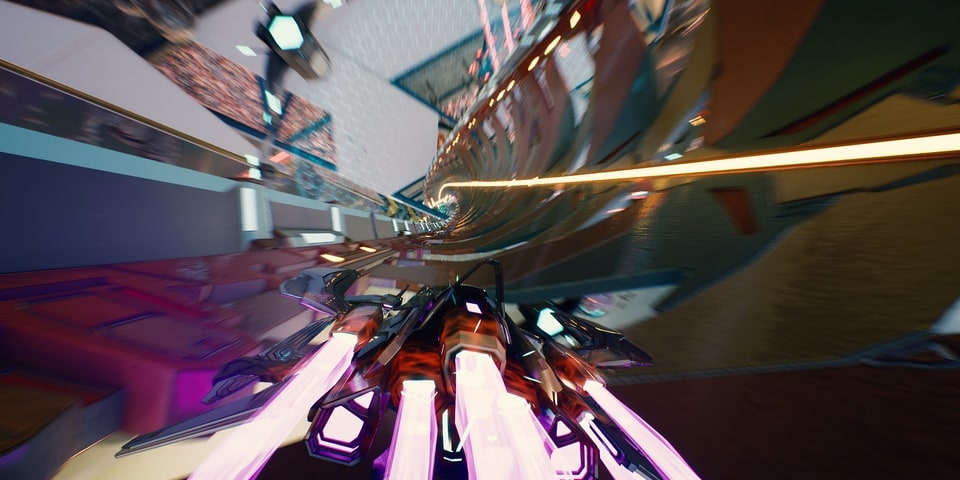Usain Bolt, Cheetahs, Sonic the Hedgehog, Bugatti Veyrons, and Formula 1 cars. All of these things are brutally fast, but they’re not as fast as Redout 2. 34BigThings have put together a future racer whose seemingly sole purpose is making your eyes stream while glorious metal and glass structures pirouette in front of your phenomenal 2000kph floating vehicle. While going fast isn’t the be-all and end-all of racing games, just like the aforementioned icons of speed, Redout 2 is something special. It’s also the new pinnacle of future racing games.
The first Redout was a welcome addition to the anti-gravity racer genre that F-Zero pioneered and Psygnosis largely perfected with the Wipeout series. New challengers have come and gone, many of whom looked to usurp the Nintendo and latterly Sony Liverpool-developed duo, but for the last few years both of these dormant behemoths have seen their previous leads eaten away. Redout 2 has timed its release perfectly, with a core audience clamouring for more anti-grav racing and new consoles to help them shine brighter than ever before.
Redout 2 has a few options for how to play including an Arcade mode, a Career path and the ubiquitous Multiplayer. Where the Arcade mode will let you hop straight in and have you going fast within moments, the Career mode will ease you in a through a series of trials before jumping up to working your way through the ‘B’, ‘A’, and ‘S’ leagues, culminating in the SRRL Invitational. ‘Ease you in’ isn’t quite the right term, as I had more problems passing the speed test – a timed loop where you need to keep your speed up constantly – than I did with most of the races in the opening league.

Redout 2 is definitely hard. It drops you into Casual mode as standard, and I found it offered up a more than decent challenge at that level. Anything above that and you’re essentially into flawless race territory with brutal opponents that test your ability to think at a hypersonic speed. The first Redout was similarly tough, but as you unlock more equipment there are times where it all levels out.
It’s clear that 34BigThings have gone for a more serious simulation-esque driving experience, albeit one that’s dressed in an anti-grav racer’s clothes. Weaponry has been removed, the controls have been seriously tightened up, and the focus is on making your way around these incredible tracks as fast as humanly possible. I welcome the change. It sets Redout off on its own path, bringing it closer in line to the purity of F-Zero, while still evoking many of the genre mainstays that Wipeout cemented in place.
That might be a bit much for some. With racing being the sole focus, 34BigThings has put together a control scheme that does the genre real justice, and it keeps you thoroughly engaged through every curve and bend. It has to, as the alternative is smacking into every single surface available. Trust me you don’t want to do that.

Redout 2 is a twin-stick racer. What I mean by that is that besides the traditional left analogue steering your craft, the right stick performs a strafing function, helping you to drift and slide through tight bends and chicanes. There are times where you need to use both in unison, and while it feels odd at first, this is a control scheme that makes perfect sense.
That right analogue pulls double duty, though, as it also controls the pitch of your craft. If you want to have any hope of retaining your speed, and crucially, winning, you’ll need to make sure your vehicle pitches into the track’s ridiculously long and tall loops and undulations.
A further bump in the road to success comes from your ship’s health and boost bars. Push the boost button too much and you’ll start to overheat. Overheat and you’ll start to lose health. You need that health for all the bumping into corners you might be doing, turning you into a fireball if you run out. Combined with the speed at play here, it makes for pure, unadulterated, visceral racing.

Customisation plays a big part in the Redout 2 experience, and there’s lots of ways to tune your vehicle, both visually and internally. Races dole out new equipment for winning or placing well, and you can immediately bung them onto your ride and see what effect they have.
The visual options are vast, and you can definitely put together something that’s going to look unique on the starting grid. It’s only a mild shame that they’re all locked away in a linear fashion rather than letting you have a muck about with a few options to start out, but I’m probably just impatient. It can make for the odd sticking point, but I think you’ll keep coming back for more. I certainly did.
While the singleplayer will keep you going for a very long time indeed, there’s multiplayer here as well, with ranked play coming soon. Hopefully everyone will have time to grasp the handling model and the tracks before ranked play arrives, but they’ll need to make sure they time it when the community is ready. In the meantime there’s SRRL Unranked, and this already gives you a taste of the serious business that Redout 2 is bringing to the starting grid.





camdaz
And for the icing on the cake…… PSVR2 support! Fingers crossed.
Dominic L
My eyes are already streaming. I’m not sure whether my stomach will cope as well if it hits PSVR2!
camdaz
Wipeout is brilliant on PSVR, especially the track in the sky with that massive drop!